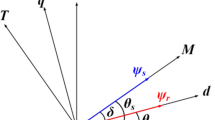Abstract
The stationary discontinuous armatures in permanent magnet linear synchronous motors (PM-LSMs), which consist of several stator sections that are distributed along the track and that the mover with PM is running without thrust force between these sections, have been proposed as a driving source for transportation systems. This design is very economical in long-distance transportation systems in factories, because the armature is engaged only when accelerated and decelerated operation is necessary. However, the stationary discontinuous armature PM-LSM contains the outlet edges which always exist as a result of the discontinuous arrangement of the armature. For this reason, the high alteration of the thrust force and the attractive force produced between the armature’s core and the mover’s permanent magnet when a mover goes through the between the armature’s installation part and non-installation part has been indicated as the problem of the stationary discontinuous armature PM-LSM. As a result, the stationary discontinuous armature design involves the velocity ripple of the mover with PM during acceleration when freewheeling changes over to re-acceleration. We have proposed and examined constant load angle control without position feedback in order to suppress the velocity ripple which occurs at the re-accelerator with the aim of achieving smooth drive of the stationary discontinuous armature PM-LSM. This paper describes the examination of constant load angle control without position feedback with the aim of suppressing the velocity ripple, which occurs in the re-acceleration portion. Also, we have examined the analysis of the effect of the outlet edge on the mover’s drive which exists as a result of the discontinuous arrangement of the armature side based on the re-acceleration characteristics obtained using constant load angle control without position feedback.
Similar content being viewed by others
References
Karita M (2001) Present status of linear drives for industry applications in Japan. In: Proc IEEJ conf linear drives for industry applications, pp 462–467
Laugis J, Lehtla T (1997) Control of special purpose linear drives. In:7th European conf on power electronics and applications 3, pp 541–546
Deng Z, Boldea I and Nasar SA (1987). Force and parameters of permanent magnet linear synchronous motor. IEEE Trans Magn MAG 23(1): 305–309
Xiong G and Nasar SA (1989). Analysis of fields and forces in a permanent magnet linear synchronous machine based on the concept of magnetic charge. IEEE Trans Magn 25(3): 2713–2719
Mizuno T and Yamada H (1992). Magnetic circuit analysis of a linear synchronous motor with permanent magnets. IEEE Trans Magn 28(5): 3027–3029
Akmese R and Eastham JF (1992). Design of permanent magnet flat linear motors for standstill applications. IEEE Trans Magn 28(5): 3042–3044
Sanada M, Morimoto S and Takeda Y (1997). Interior permanent magnet linear synchronous motor for high-performance drives. IEEE Trans Ind Appl 33(4): 966–972
Azukizawa T (2003) Status of linear drives in Japan. In:Proc IEEJ conf linear drives for industry applications, pp 12–19
Seki K, Watada M, Torii S, Ebihara D (1997) Discontinuous arrangement to long stator linear synchronous motor for transportation system. In:Proc IEEE conf on Power electronics and drive systems, pp 697–702
Seki K, Watada M, Torii S, Ebihara D (1997) Experimental Device of long stator LSM with discontinuous arrangement and result. In:7th European conf on power electronics and applications 3, pp 541–546
Kajioka M, Oka K, Watada M, Torii S, Ebihara D (2000) Optimal drive control timing in discontinuous arranged linear synchronous motor transfer system. In:Proc conf on power electronics electrical drives automation & motion, pp A2–25–A2–30
Endou A, Watada M, Torii S, Ebihara D (2000) The various characters by the establishment angle of the carriage course of the PM-LSM with discontinuous arrangement primary. In:IEE Japan, the papers of technical meeting of linear drives, LD-00-91 (in Japanese)
Kim YJ, Watada M, Torii S, Ebihara D (2002) A study of the discontinuous primary linear synchronous motor in order to decrease the vibration. In:Proc conf on electrical engineering II, pp 908–912
Author information
Authors and Affiliations
Corresponding author
Rights and permissions
About this article
Cite this article
Kim, YJ., Dohmeki, H. Driving characteristics analysis of stationary discontinuous armature permanent magnet linear synchronous motor for factory automation systems. Electr Eng 89, 617–627 (2007). https://doi.org/10.1007/s00202-007-0072-4
Received:
Accepted:
Published:
Issue Date:
DOI: https://doi.org/10.1007/s00202-007-0072-4




